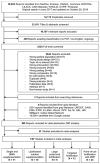Micronutrient Supplementation and Fortification Interventions on Health and Development Outcomes among Children Under-Five in Low- and Middle-Income Countries: A Systematic Review and Meta-Analysis
- PMID: 31973225
- PMCID: PMC7071447
- DOI: 10.3390/nu12020289
Micronutrient Supplementation and Fortification Interventions on Health and Development Outcomes among Children Under-Five in Low- and Middle-Income Countries: A Systematic Review and Meta-Analysis
Abstract
Micronutrient deficiencies continue to be widespread among children under-five in low- and middle-income countries (LMICs), despite the fact that several effective strategies now exist to prevent them. This kind of malnutrition can have several immediate and long-term consequences, including stunted growth, a higher risk of acquiring infections, and poor development outcomes, all of which may lead to a child not achieving his or her full potential. This review systematically synthesizes the available evidence on the strategies used to prevent micronutrient malnutrition among children under-five in LMICs, including single and multiple micronutrient (MMN) supplementation, lipid-based nutrient supplementation (LNS), targeted and large-scale fortification, and point-of-use-fortification with micronutrient powders (MNPs). We searched relevant databases and grey literature, retrieving 35,924 papers. After application of eligibility criteria, we included 197 unique studies. Of note, we examined the efficacy and effectiveness of interventions. We found that certain outcomes, such as anemia, responded to several intervention types. The risk of anemia was reduced with iron alone, iron-folic acid, MMN supplementation, MNPs, targeted fortification, and large-scale fortification. Stunting and underweight, however, were improved only among children who were provided with LNS, though MMN supplementation also slightly increased length-for-age z-scores. Vitamin A supplementation likely reduced all-cause mortality, while zinc supplementation decreased the incidence of diarrhea. Importantly, many effects of LNS and MNPs held when pooling data from effectiveness studies. Taken together, this evidence further supports the importance of these strategies for reducing the burden of micronutrient malnutrition in children. Population and context should be considered when selecting one or more appropriate interventions for programming.
Keywords: effectiveness; efficacy; fortification; iron; lipid-based nutrient supplement; micronutrient; under-five; vitamin A; zinc.
Conflict of interest statement
The authors declare no conflict of interest.
Figures











References
-
- Stevens G.A., Finucane M.M., De-Regil L.M., Paciorek C.J., Flaxman S.R., Branca F., Pena-Rosas J.P., Bhutta Z.A., Ezzati M., Nutrition Impact Model Study Group Global, regional, and national trends in haemoglobin concentration and prevalence of total and severe anaemia in children and pregnant and non-pregnant women for 1995–2011: A systematic analysis of population-representative data. Lancet Glob. Health. 2013;1:e16–e25. doi: 10.1016/S2214-109X(13)70001-9. - DOI - PMC - PubMed
-
- Stevens G.A., Bennett J.E., Hennocq Q., Lu Y., De-Regil L.M., Rogers L., Danaei G., Li G., White R.A., Flaxman S.R., et al. Trends and mortality effects of vitamin A deficiency in children in 138 low-income and middle-income countries between 1991 and 2013: A pooled analysis of population-based surveys. Lancet Glob. Health. 2015;3:e528–e536. doi: 10.1016/S2214-109X(15)00039-X. - DOI - PubMed
Publication types
MeSH terms
Substances
Grants and funding
LinkOut - more resources
Full Text Sources
Medical

